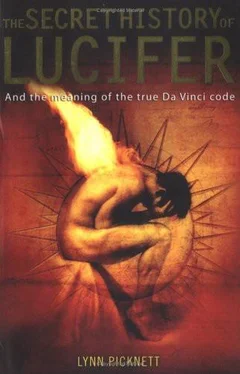The Dutch historian Huizinga, in his classic book Homo Ludens [Playful Man], deals with playfulness and its importance in human culture throughout history. This spirit of playfulness is, I believe, an important vein running through the Gnostic tradition ... Churton mentions an early example in the figure of ... Simon Magus 40
Acknowledging that Churton's previous book, The Golden Builders,
skilfully placed the Rosicrucians within the context of the emerging gulf between science and religion, a gulf which they wished to prevent by creating a universal system of knowledge, linking religion, science philosophy and art. The Rosicrucians embodied this vision in a brilliantly created mythology with a strong element of playfulness."
Therefore Leonardo would have been in every way the perfect Rosicrucian: his scientific, artistic and `religious' (i.e. Johannite) sensibilities being enriched and enhanced by his essential understanding of jokes and playfulness. This creates a mind that sees immense and often apparently contradictory possibilities in everything, that espies a unifying force beneath all nature - and that particular God is one of laughter, just like Goethe's Mephistopheles, but infinitely more powerful, hopeful and full of light. And it may be significant that a nineteenth-century poster advertising a Rosicrucian salon in Paris depicted Leonardo as Keeper of the Grail ...
Cracking the Da Vinci Shroud Code requires the same sort of off-beat perception - which has absolutely no connection with academic standing or an intimate knowledge of Leonardo's brushwork - that will see for itself the giant phallus made of rocks towering above Mary's head in the Virgin of the Rocks, the femininity of the young `St John' or the disembodied hand clutching a dagger in the Last Supper.
To those who eagerly quote the latest desperate outpourings from the usually rather acidulous pens of the remaining `Shroudies' (those who, despite all the evidence to the contrary, insist on believing that the alleged relic is genuine), let me point out certain key factors about the image on the shroud that prove, even to a child - indeed, especially to a child" - that it cannot be anything but a fake. First, the height of the man is literally impossible. As it is supposed to be Jesus' winding cloth, there is a front and a back image, roughly joined at the crown of the head - yet the man is two inches shorter at the back than he is at the front, which would indeed be a miracle. Shroudman is actually 6ft 10in at the front and 6ft Bin at the back, although nowhere in the New Testament does it remark about Christ's astonishing height (and uniquely sloping head). Although it is true that the Christian Bible is not much concerned with physical appearance, if Jesus were a giant surely some sort of remark would have crept in, especially in an era when great height was associated with kingship 43
There is absolutely no doubt about this: in my capacity as a consultant for the National Museum of Photography, Film and Television's exhibition, `The Unexplained', in 1999 I, along with Clive Prince had the golden opportunity to put our theory about Shroudman's height to the test. (Previously we had simply done the calculations.) The museum had made the full-length photographic reproduction of the Shroud the focus of a huge, otherwise completely bare room, displaying it on a massive, specially built light-box no more than two feet from the ground. This enabled the visitor to look down at the image, besides being able to stand back at a distance and see it from all angles - much more telling than being crammed shoulder to shoulder in a long line of pilgrims and shuffling along to see no more than a couple of inches of the real thing at roughly eye-height. Conveniently Clive is exactly six foot tall, so we were able to measure the height of Shroudman with some precision, by laying him on the ground beside it, aligned with the top of the head. We also had assistance from the museum staff. And yes, Shroudman is enormously, impossibly tall ... Of course as a projected image he could be any height at all from tiny to gigantic, although in that case one has to wonder why a genius like Leonardo failed to correct such a blunder. But then, was it actually a mistake - could the ludicrous height actually have been left there deliberately?
Remember this is the man who set a giant phallus on the Virgin Mary's head and got away with it for 500 years; the artist whose `St John' is a woman and whose Last Supper contains a disembodied hand clutching a dagger that virtually no one ever notices. Leonardo was the ultimate psychologist, knowing - even relying on - the fact that people only ever see what they expect or want to see. If that were not true, he would have been in serious trouble virtually before the paint dried on many of his masterpieces. He seems to be creating `errors' of a particular sort, but not for the masses to notice, because he had no intention for them to do so and was confident that they would miss them anyway, but perhaps to speak profoundly to `those with eyes to see'.
Here he has created not only an impossibly tall Jesus, but the man's head is apparently severed. Indeed, there is a distinct demarcation line at the base of the neck, which can be seen perfectly, like many of the other details, when viewed in photographic negative. Once again, this is beyond reasonable doubt: we had the image run through a computer programme that turned it into a species of contour map," making the discovery that the image does indeed suddenly stop completely at the exact position of the line, picking up again at the upper chest. Why should this be?
One reason was no doubt simply practical. It is obvious that the image of the head at the front was created at a different time from the rest of the front and the whole of the back. The face is actually a different size and scale from the body,45 being also narrower and proportionately smaller than the head at the back (which is also at a completely different angle) 46 The ears are missing, replaced by curious blank strips between the face and the hair, which gives an oddly neat frame to the face (unlikely were the body supine) 47
In fact, we discovered very quickly during our experiments that this peculiar foreshortening is simply a sideeffect of using a lens in the camera obscura, a sort of fish-eye effect. Leonardo is known to have ground his own lenses, even making himself a rather `cool' pair of dark blue spectacles. (But again, one wonders why? Why did he need to protect his eyes from intense light and heat? Did he make the glasses specially for his Shroud work, in which - as we discovered for ourselves48 - when creating similar images, both heat and light must be kept at a maximum for over 24 hours?)49 The question of a lens led us to make a particularly exciting discovery: we know Leonardo used one at least in his manufacture of the face of the Shroud of Turin because it can clearly be seen in the dead centre of the face - the bridge of the nose - as a dark circle on the negative and a light circle on the positive image. This is a photograph of the lens itself.50
However, this being Leonardo, one layer of explanation will never be enough. Multi-faceted himself, he demands that we engage our brains, hearts and souls (not to mention our sense of the absurd): his unsettling representations striking at the core of the psyche, and sometimes giving a curious twist to the heart. As in his uncompromising satire on Marian virginity, The Virgin of the Rocks, his work may often be curiously dark in the literal, artistic sense, but it is also white-hot with anger - and that anger communicates itself loud and clear after 500 years to `those with eyes to see'.
Considering all the bold and outrageous Johannite symbolism in Leonardo's paintings, was he also saying in his depiction of a very obviously separate head on the Shroud of Turin, that `one who was beheaded is "over" - morally and spiritually - one who was crucified'? Certainly that would be the neatest and ultimate symbol of the real `Da Vinci code' .. .
Читать дальше












